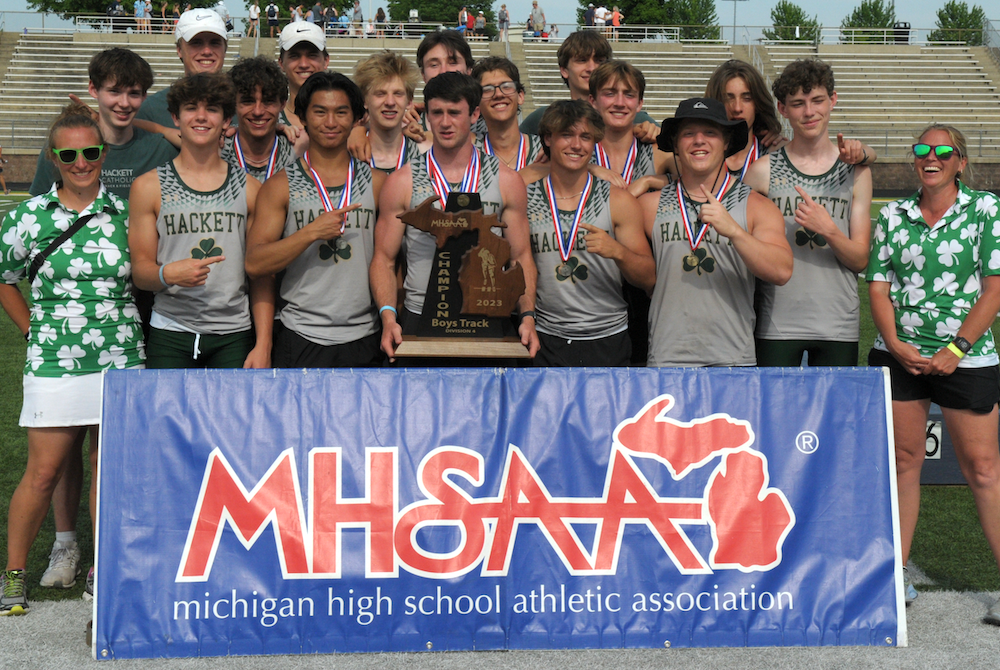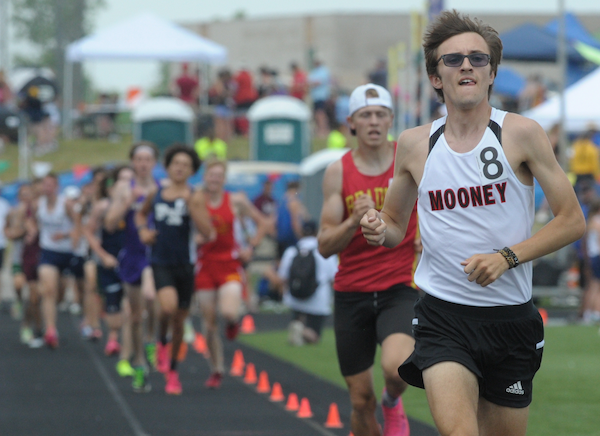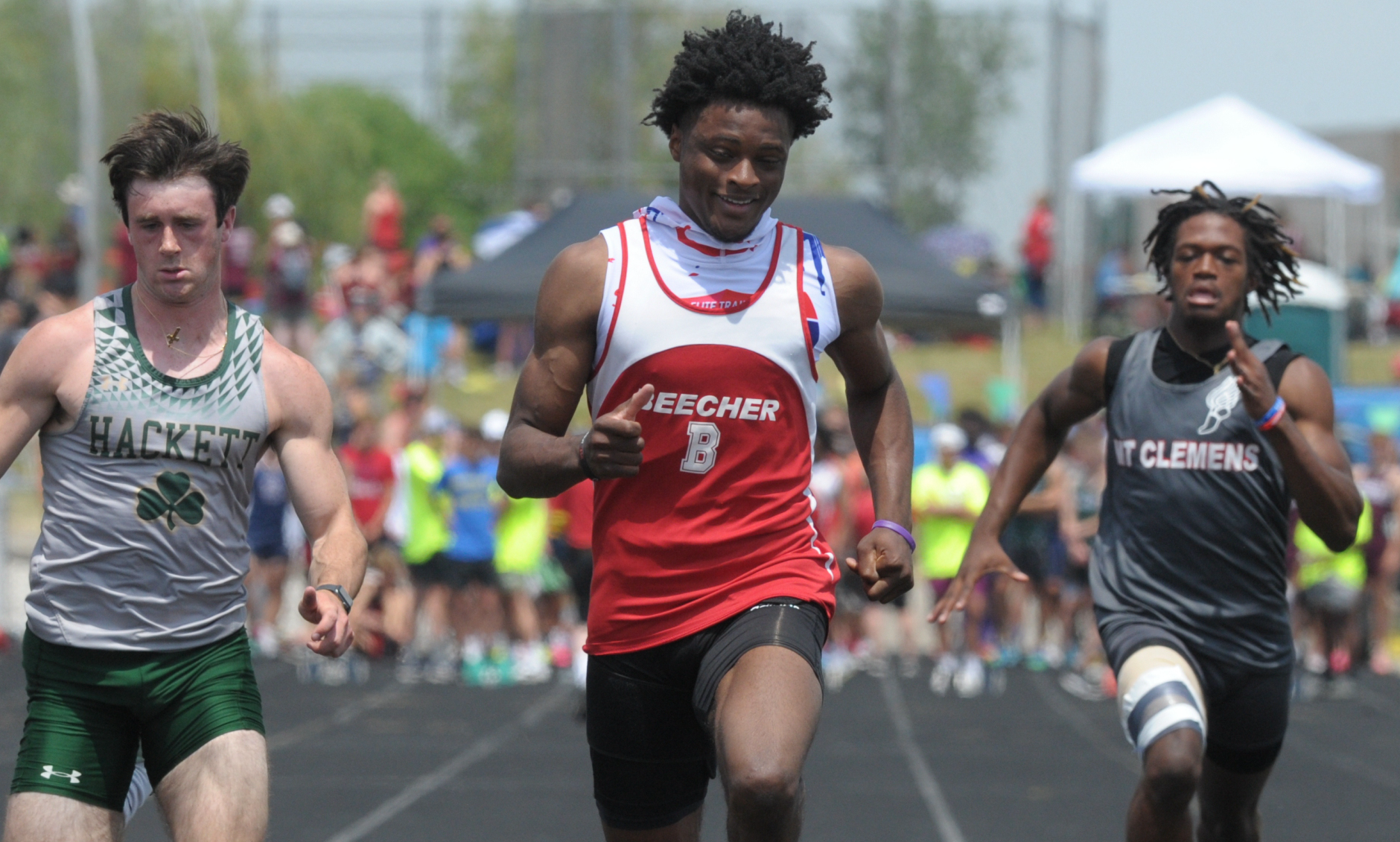
Record Throws Set Up Carson City-Crystal's Soar to 1st Title
By
Will Kennedy
Special for Second Half
June 5, 2021
HUDSONVILLE —For the first time in school history, the Carson City-Crystal Eagles boys track & field team has claimed the title of state champion.
Carson City-Crystal finished Saturday’s Lower Peninsula Division 4 Finals with 68.5 points, 10.5 more than the closest competitor. The Eagles did it with a small group – only eight athletes travelled to Hudsonville to compete. But by the end of the day, all of them had earned the title of all-state athlete.
Junior Zane Forist got the day started off on the right foot in the field events. He won the discus with a throw of 196-5, nearly 60 feet more than the second-place finisher. He also won the shot put with a hurl of 62-4, over 14 feet more than anybody else.
Both were meet records – the discus toss breaking the 190-0 throw by Litchfield’s Jacob Patrick in 2012. The shot put bested the former LPD4 record of 58-5.25 by Ottawa Lake Whiteford’s George Flanner in 2007. And together gave Carson City-Crystal a comfortable lead heading into the track finals, helping alleviate the pressure on the rest of the team.
“When you have the number one thrower, that kind of helps,” said Eagles coach Grant Woodman. “The field events set the tone, and then we let our distance guys ease into it and it just works out for us.”
 The distance runners did what they had to do to get the job done. Senior Coleman Clark earned second place in the 1,600 and the top spot in the 3,200. Those points helped keep Saugatuck at bay and put the Eagles firmly atop the podium.
The distance runners did what they had to do to get the job done. Senior Coleman Clark earned second place in the 1,600 and the top spot in the 3,200. Those points helped keep Saugatuck at bay and put the Eagles firmly atop the podium.
Clark said that in other years, he focused on his individual performance. But this time around, he knew he wanted to give it his all for the overall team victory.
“This year, going into the season knowing we would have a top team, I knew I was going to be team-focused,” Clark said. “It feels so good to hit that top goal as a team. We knew we could do it.”
Jaylin Townsend from Flint Beecher set the standard in sprint events. He came away with an individual title in the 100 with a personal record time of 10.98 and edged Saugatuck’s Benny Diaz for first in the 200 with a time of 22.75. Townsend also helped lead the Buccaneers to a title in the 800 relay with a school record of 1:30.59.
The sophomore said that when he crossed the finish line as a Finals champion for the first time, he got excited realizing he was among the elite of the elite runners in Michigan.
“It feels great,” Townsend said. “I’m always thinking that I have to win, I have to win. … The excitement through my head is just so crazy. Only a couple people can really be state champions, and I’m one of them.”
 Diaz earned two individual titles himself, in the 110 hurdles with a time of 14.77 and in the 300 hurdles, crossing the line in 39.59.
Diaz earned two individual titles himself, in the 110 hurdles with a time of 14.77 and in the 300 hurdles, crossing the line in 39.59.
While all the excitement was taking place on the track, Wyoming Potter’s House Christian junior Jok Nhial finished first in the long jump with an incredible leap of 21-09.50, a personal record. He shattered his previous PR by seven inches, something he wasn’t expecting to do Saturday.
“It feels amazing that I’m able to do this at the state championship,” Nhial said. “I didn’t expect to make a PR today, or even break our school record. It was a great moment. I’ve worked so hard and for this to be the outcome, it feels great.”
But the true triumph of the day belonged to Carson City-Crystal. The eight athletes and the coaching staff were able to put together a season that none of them will soon forget.
“Everybody stepped up and did their part,” Forist said. “It really is a team thing. It wasn’t just a one-man show. Everybody did their thing. It’s so awesome.”
PHOTOS: (Top) Carson City-Crystal celebrates its first MHSAA Finals championship in track & field. (Middle) Flint Beecher's Jaylin Townsend, right, races Saugatuck's Benny Diaz. (Below) The Eagles' Coleman Clark races in the 3,200. (Photos by Will Kennedy.)

Thrower Claims Lone Individual Title to Lead Hackett to Team 3-Peat
By
Tom Lang
Special for MHSAA.com
June 3, 2023
Kalamazoo Hackett Catholic Prep just keeps winning and winning.
This time the Irish took home their fourth title in the last five Lower Peninsula Division 4 Track & Field Finals, on Saturday at Hudsonville.
Hackett’s only individual title was taken by discus winner Nathan Buchmann, a senior, who was fine knowing he was the shortest in stature among all the sizable competitors.
“In the offseason after football I worked out every day, working towards this goal,” he said after getting his medal. “I would say this takes 80 percent technique and 20 percent strength to throw the discus. So, length can help but if you have good technique and are really strong, that will play into it.
“I think we are very balanced throughout the meet today,” he said about teammates that scored points in finishes other than first place. “We have 13 guys here today, and we have people in a lot of the races. But I do not run; I have too short of legs to be a fast runner,” he said with a chuckle.
Buchmann had to work through a hip injury to compete this spring.
“I think the setbacks are what make you strong,” he said. “You can either give up through the setbacks or push forward and become better.”
 Coach Charissa Dean agreed.
Coach Charissa Dean agreed.
“The kids have big hearts,” she said after all the points were totaled and the Irish were on top once again, with 53. “They worked hard. They had a lot of potential when we started the season. And we had a lot of drive to put in the work, and we are happy the results came out the way they did.”
Reading was runner-up at 47 points, followed by Wyoming Potter’s House Christian with 42, then Fowler and Flint Beecher each with 37 points.
Senior Lezawe “Moses” Osterink, of Potter’s House Christian, placed second in 1,600 but took the 3,200 title as defending champ of both. He dominated the latter by lapping the field with a final lap kick that resembled more of a superhero speedster.
“Nobody really took it out that hard at the start,” he said. “There was a freshman (Marek Butkiewicz of Hackett) that tried to get the pace going quick, but me and Dakota (Dykhuis of Montabella) just kind of sat back and gradually pulled him through.
“We took it gradually, and I was just relying that I could kick.”
Kick did he ever. The trio were neck and neck the majority of the race in a grouping ahead of the pack.
“With 400 to go I just tried to go all out,” Osterink said. “I had a lot more left than I thought and I was pleased with the win. Not really the time, but that doesn’t matter, especially this hot out.”
The overall meet was in the low 90s/high 80s heat and searing sun all day. So, race officials allowed the unique opportunity for coaches to spray the runners with water and give them water bottles.
“It was very weird because I’ve never taken water to drink while I’m running, so I didn’t know how that would feel,” Osterink said. “And they were spraying us and hitting us in the face. It was kind of fun.”
Junior Tyler Lenn of Marine City Cardinal Mooney defeated Osterink at his own game in the 1,600.
“I’m feeling great,” Lenn said after grabbing the medal. “I said to a newspaper after one of my races (during the season) I was right where I wanted to be. This has been a long rebuilding process for me since an injury back in the fall, and I set a pretty high goal the day the injury happened. I was telling myself I needed to fulfill what I said I would do at the beginning of last cross country season. And that is what I did today.”
Lenn suffered an ankle sprain from a misstep that turned worse because he kept running through the season on it.
“Coming back from that was pretty tough, but I wouldn’t have it any other way,” he said.  “Perseverance; I said from the beginning what I was going to do. I kept my eye on that target, and no matter the circumstances life threw at me, that I was going to make it happen and I am a man of my word.”
“Perseverance; I said from the beginning what I was going to do. I kept my eye on that target, and no matter the circumstances life threw at me, that I was going to make it happen and I am a man of my word.”
Jaylin Townsend, a senior from Flint Beecher, dominated the short races. He won the 100 dash (10.67) and 200 dash at 22 seconds flat. It was his third 100 win at a Finals.
“I put in a lot of work; I had to three-peat,” he said after the 100. “There’s a lot of great competition here, so I knew I had to come out and run my best.”
Concord in the 400 (43.72), Buckley in the 800 (1:30.76) and 1,600 (3:29.13) and Potter’s House in the 3,200 (8:14.18) were relay champs Saturday. Reading’s Tayshawn Bester won the 110 hurdles (15.13), and Athens’ Landen Bennett won the 300 (39.85). Caseville’s Nathan Feltner won the 400 (50.76), and Vestaburg’s Owen Patton claimed the 800 (1:55.11).
Fruitport Calvary Christian’s Bradley Richards won the high jump (6-10), and Peck’s Alex Affer won the long jump (23-4). McBain Northern Michigan Christian’s Isaac Bowden was first in pole vault (13-0), and Brown City’s Kyle Affer won shot put (49-2).
PHOTOS (Top) Kalamazoo Hackett Catholic Prep celebrates its third-straight LPD4 title Saturday. (Middle) Cardinal Mooney's Tyler Lenn, far right, sets the pace in the 1,600. (Below) Flint Beecher's Jaylin Townsend, middle, crosses the finish first for one of his two sprint championships. (Photos by Ken Swart/RunMichigan.com.)

